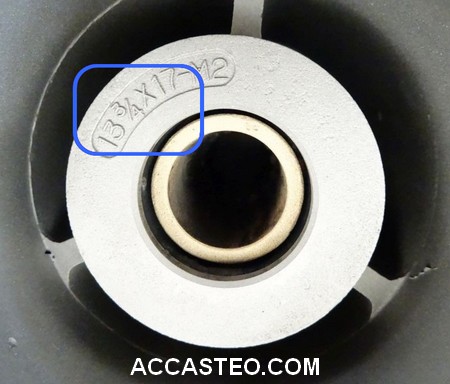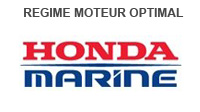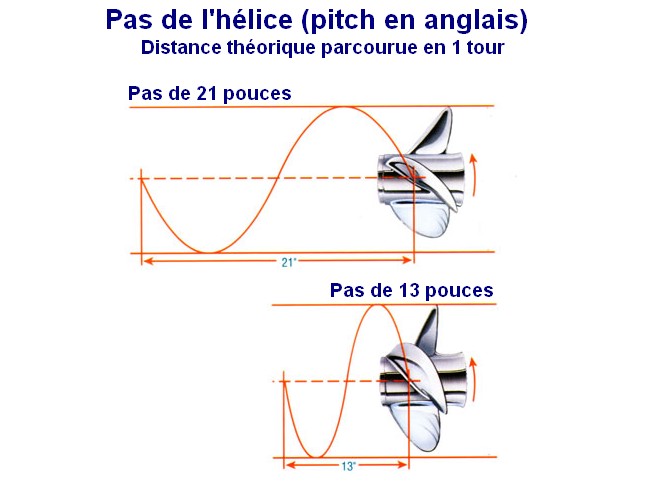Product successfully added to cart
There are 0 items in your cart.

Your best technical partner to repair your engine at low cost!
Any question ? Please feel free to contact us

Welcome Log in Your account

Disassemble the propeller, then inspect the hub (cylindrical central part) and its sides. You should find engraved there a reference of that type: 9 7/8 X 10 1/2 for example, where 9 7/8 is the diameter and 10 1/2 is the pitch, expressed in inches. 1 inch: 2.54 cm
IDENTIFICATION OF DIAMETER AND PITCH ENGRAVED ON THE PROPELLER HUBhere, a Yamaha 13 3/4 X 17 exterior side view (rear of the propeller) |
 |
You can also find a manufacturer reference of the type: for example, 664-45941-01 at Yamaha.
 |  |  |  |
In all cases, the choice of the propeller must be made according to the optimum operating speed of your engine, in its usual operating conditions. This is to achieve optimal engine performance and minimal wear.
Usual operating conditions? It's just, when you take the boat out, how is it loaded? Do you always leave with 2 friends, with the cooler full of ice, and full of fuel?
If so, the objective must be that with the new propeller the engine takes its turns well with this load on board.
All outboard motors have an optimum operating range, set by the manufacturer generally between 4000 and 6400 rpm.
Important note: Too low a speed leads to premature and serious engine wear. Same thing with too high a speed, with an additional risk of breakage.
 |  |  |  |
Once this information has been retained, do a top speed test with the boat, trimming at full throttle to find the maximum rpm before cavitating (see below). Memorize it...

If your engine is a Yamaha F80 for example. It should spin between 5000 and 6000 rpm. So ideally 5500.
Your engine, at full speed, only takes 4800 rpm? The pitch of the propeller is therefore too long, it is necessary to choose a “shorter” propeller. If the current propeller is a 13 X 19, it can be replaced by a 13 X 17. That is 2 inches less.
For 1 inch less step, we will gain 300 rpm and conversely, for 1 inch more step, we will lose 300 rpm.
So with the 13 X 17, we should gain 600 laps, and end up in the middle of the range, in the optimal rpm.
To summarize:
If your engine does not take enough revs, you must choose a smaller pitch. If the motor is overspeeding, a larger pitch should be chosen.
Professional Tip:
Determine more precisely the speed that your engine takes at full speed using the trim
WARNING: carrying out a speed test requires caution, to be done as far as possible with 2 people. One is at the helm, the other will watch the rev counter. Always wear a vest. Respect the speed in the 300m band. Carry out your test in calm seas.
Under normal boat load conditions, and in perfect safety, leave the 300m band with the engine in the lowest possible position, then gradually accelerate fully. Once at full speed, raise the engine with the trim switch on the box, by pressing for 2 seconds until the start of the increase in speed.
Listen to the motor, then raise the motor again by pressing the switch for 1 second. At some point it will increase significantly in the revs, and the boat will pick up more speed. Continue to climb until the engine will “rumble”, you will also feel a vibration. Don't worry, it's the cavitation of the propeller, nothing bad for a few moments if you don't exceed the maximum speed...
Lower the engine by small pressures to stop hearing this noise, and see what speed you are at. If you are at the manufacturer's optimum rpm, your propeller is perfectly suited. If not, you now have a clear idea of which propeller will allow you to reach the right engine speed.
If in doubt, do not hesitate to contact us
Product successfully added to cart
There are 0 items in your cart.